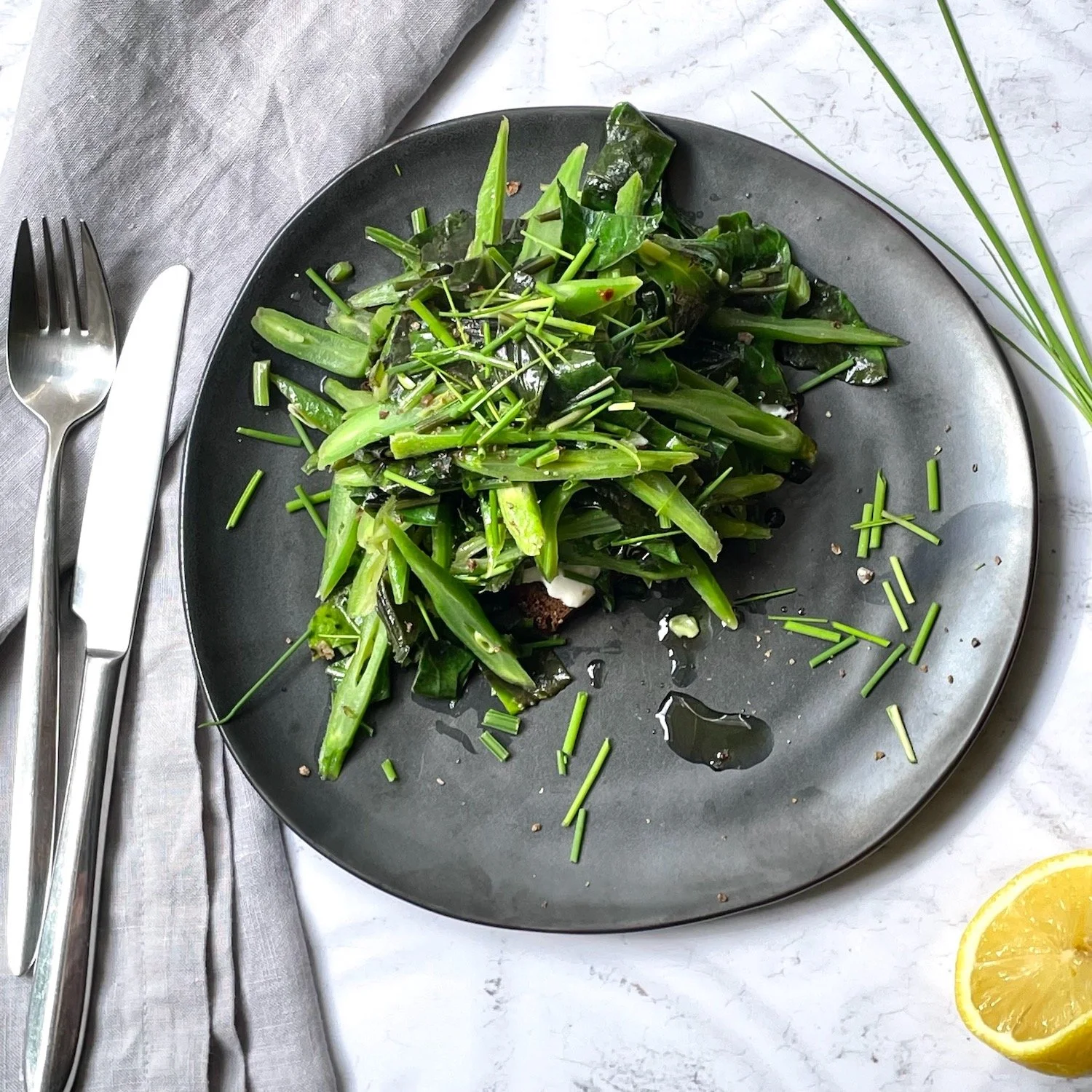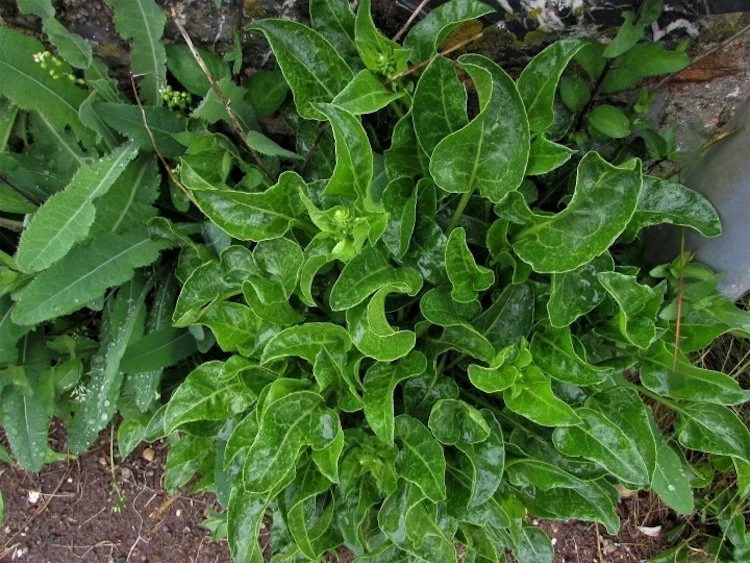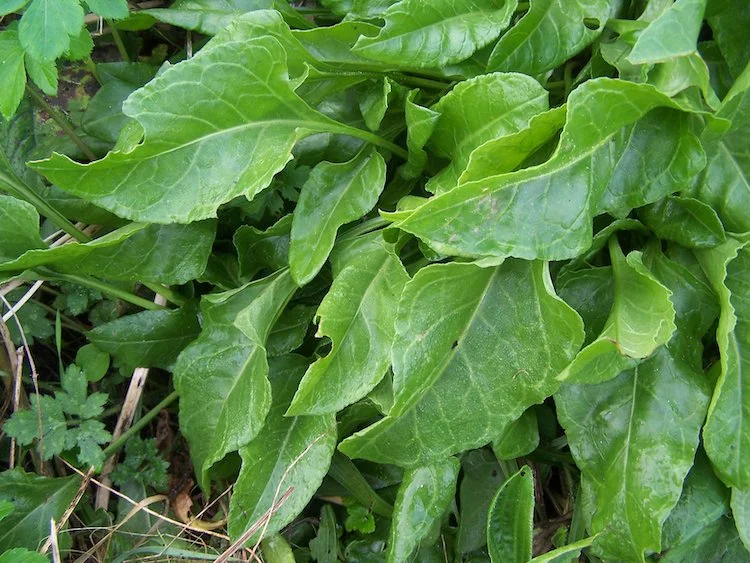Wild sea beet, runner beans & Drumturk goats curd on toast
Cor bloody blimey! This is one of the best things I’ve eaten in ages. And exemplifies the way I love to eat and stand for passionately: natural, diverse, seasonal, local, sustainable, a little bit of wild, quick (knocked together in just a few minutes), simple, and JUMPING with flavour.
If that’s your bag too, then read on.
Just a few choice ingredients, with not a whole lot done to them, to let their beauty shine through. Wild sea beet and organic runner beans picked at the peak of their season when flavour is at its radical best, to borrow from supplier Natoora’s ‘radical seasonality’ mission terminology. Wilted in a touch of cultured butter, the flavour pinnacle of butters (read why in my article, Why You Should Upgrade to Cultured Butter). Seasoned with crushed white Sarawak pepper, which I chose for its uplifting citrussy notes, a beautiful counterpoint to the greens. Piled vertiginously high onto a slice of 100% wholemeal toast – from Wild Hearth Bakery, many times winner of Scotland’s Bread Championships. Toast spread thickly with Drumturk Cheeses’ Scottish Goats Curd – creamy, satisfyingly salty, lemony fresh with a gentle goaty tang. Some chives from a pot by the back door, a squeeze of lemon and a drizzle of EVOO (healthy fats) to finish.
Great for breakfast, brunch, or lunch.
About sea beet
The wild ancestor of beetroot, sugar beet and Swiss chard, sea beet is like a majestic spinach, hence its alternative name, wild spinach. Its glossy dark green, thick, succulent leaves are more substantial, more flavourful, and less astringent (it contains about half as much oxalic acid, 581mg per 100g raw vs about 1000mg for spinach, but ranging as high as 1,287mg/100g),[1,2] with a delicious slightly salty tang. Much more satisfying to eat – in taste and texture!
It grows around most of the British coast on sandy dunes, shingle, rocky outcrops and clifftops, saltwater marshes and mudflats.
What’s great about it
One serving contains:
Almost half of your ≥5-A-DAY
Over a third of your recommended daily intake of fibre (11g of 30g)
A fifth of your weekly plant target.
Sea beet is rich in vitamin B9, also called folate or folic acid, vitamin C, and minerals. 100g (raw weight) contains:
Twice the adult daily requirement of folate (201%)
110% vitamin C
52% manganese
43% of iron for adult males and females aged 50+, 25% for females aged 11-49
34% of magnesium for women, 27% for men
28% potassium
16% copper
15% of zinc for women, 12% for men.*[1,3]
*Values are % DRVs per 100g, specifically the % average requirements (EAR) or % RNI where specified, % safe intake where there was insufficient evidence to set an EAR or RNI.
In peak season
When UK-grown produce is at its best and most widely available:
Runner beans: July-September
Wild sea beet: The leaves can be picked all year, but are at their best in spring when they’re young and tender. Some sources say they develop a bitterness when the plant goes into flower, from July-August/September, but there wasn’t a trace of bitterness to those I got from Natoora last week (w/c 21/8/23). They list them as being in ‘peak season’ late February through to April, ‘late season’ May to the first week of August, back in peak for the rest of August, reappearing as ‘early season’ from September right on through to mid-February. In summer, if you can only find plants in flower, switch them out for samphire, spinach, or chard, all of which are in peak season.
How many of your ≥5-A-Day: 2.25 per serving
Plant points: 5.75
Time
Prep: 3-4 minutes
Cooking: 4-5 minutes
Ingredients (per person)
Greens:
80g wild sea beet, washed and shaken dry in a tea towel (removing excess water helps to avoid that nasty pooling you get in the bottom of the pan with leafy greens like spinach and chard)
100g organic runner beans, washed, topped and tailed
Small knob of grass-fed butter, preferably cultured for max flavour, I had 7g/a ½ tablespoon
Pinch dried red chilli flakes
¼ teaspoon flaked salt (I used a scant ½ teaspoon, but I have low blood pressure and follow a ketogenic diet so need to actively add salt to my diet; if you need to be careful of your salt intake, stick to a ¼ teaspoon)
Pinch crushed white Sarawak peppercorns (or regular black), ground coarsely in a mortar and pestle – don’t pulverise to a powder, you want visible pieces for bursts of fresh, fruity flavour
Squeeze organic lemon juice (do go organic as lemons are on the PAN UK Dirty Dozen list, produce with the highest pesticide residues)
Assembly:
1 slice 100% wholemeal bread (see recommendations below)
Drumturk Cheeses’ Scottish Goats Curd, enough for a thick spreading, how much you need will obviously depend on the size of your slice of bread, I used 40g
Fresh chives, chopped
Another pinch of the crushed pepper
Generous drizzle organic EVOO to finish, a dessertspoon or so
Method
Sort the washed and dried sea beet into two piles: the smallest leaves with delicate stalks that won’t require any chopping, and anything larger than that. Set the smallest leaves aside. Taking all the rest, cut away the stalks, gather them together and slice finely. Then chiffonade the leaves – stack them on top of each other, largest to smallest, roll them up, cigar style, and slice into wide ribbons (about 2cm wide).
Next, slice the runner beans finely on the diagonal.
Place a medium pan on a medium heat, add the butter, salt, pinch chilli flakes, pinch crushed pepper, and heat until the butter is melted.
Add the sliced runner beans, reduce the heat to medium-low, place the pan lid on top, cocking it slightly, and sauté until they’ve begun to colour up and soften, but are still too crunchy to be enjoyable, about 2-3 minutes. Meantime, pop the slice of bread in the toaster so it will be ready once the greens are done. (We’re shooting for al dente green beans and just wilted sea beet. The sea beet will take around 1½ minutes, so you want to cook the beans on their own just long enough to be al dente in another 1½ minutes or so.)
Add the finely sliced sea beet stalks, give everything a stir/shake the pan to distribute, return the cocked pan lid and cook for another 30 seconds or so.
Add the ribboned leaves, turn the heat up to medium, and cook until just wilted, about 1 minute, by which time the runner beans should be al dente, stirring or shaking the pan intermittently. Immediately remove the pan from the heat. (TOP TIP: I always remove the pan from the heat just before leafy greens look ready as they continue to cook with residual heat. Cook until they’re ready and they’re often overdone and leaky by the time they reach your plate.)
Add a squeeze of lemon juice, stir through, check the seasoning and adjust to taste if required.
Spread the toast thickly with the goats curd, set on a plate, turn the greens out on top gathering them up into a towering pile. Use your hands if they can take the heat – much better at creating height than spoons.
Sprinkle over the chives, another pinch of crushed pepper, finish with a generous drizzle of EVOO and serve immediately.
Recommended products & stockists
Wild sea beet and organic runner beans – I ordered both from Natoora. You can of course forage your own sea beet and you’ll find organic runner beans in good veg box schemes and greengrocers. I’ve not seen organic runners in supermarkets to date, but you will find organic green beans.
Cultured butter – see this article for my top recommends, Why You Should Upgrade to Cultured Butter.
White Sarawak peppercorns – stockists include Natoora, Terre Exotique at Sous Chef, and organic ones from Spice Mountain.
Bread – I used Wild Hearth Bakery’s Swiss Highland Rye. I also recommend their Yorkshire Wholewheat, the only other 100% wholemeal flour sourdough I’m aware of in Scotland (if you know of any others, please let me know in the comments). If you’re gluten-free, The Heart of Nature’s Seedful Slices are a great option, packed with chompy seeds. Available direct and from Waitrose.
Drumturk Cheeses’ Scottish Goats Curd is available locally from Mellis from April to September and for most of the year from maker Denise Ferguson’s farm shop in Blairgowrie, Perthshire.
EVOO – I used Duchy Organic, a great value (£6) all-rounder for use in cooking, salads, dips and drizzling.
References
de Cortes Sánchez-Mata M, Tardío J (eds). Mediterranean Wild Edible Plants: Ethnobotany and Food Composition Tables. New York: Springer; 2016.
Shi A, Mou B, Correll JC. Association analysis for oxalate concentration in spinach. Euphytica. 2016;212(1). doi: 10.1007/s10681-016-1740-0.
Department of Health. Dietary Reference Values: A Guide. London: HMSO; 1991. Available from: https://assets.publishing.service.gov.uk/government/uploads/system/uploads/attachment_data/file/743790/Dietary_Reference_Values_-_A_Guide__1991_.pdf.



